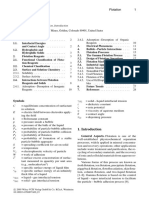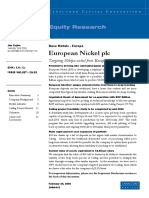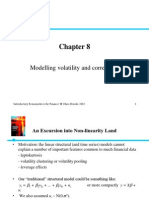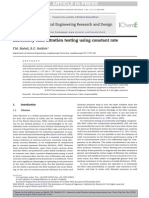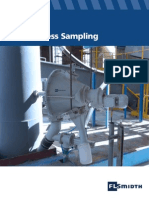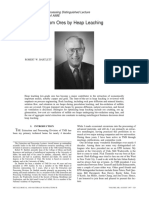(1996) West J. N. - Nifty - Hydrometallurgy in The Sand Dunes
(1996) West J. N. - Nifty - Hydrometallurgy in The Sand Dunes
Uploaded by
Luis Miguel La TorreCopyright:
Available Formats
(1996) West J. N. - Nifty - Hydrometallurgy in The Sand Dunes
(1996) West J. N. - Nifty - Hydrometallurgy in The Sand Dunes
Uploaded by
Luis Miguel La TorreOriginal Title
Copyright
Available Formats
Share this document
Did you find this document useful?
Is this content inappropriate?
Copyright:
Available Formats
(1996) West J. N. - Nifty - Hydrometallurgy in The Sand Dunes
(1996) West J. N. - Nifty - Hydrometallurgy in The Sand Dunes
Uploaded by
Luis Miguel La TorreCopyright:
Available Formats
Nifty - Hydrometallurgy in the Sand Dunes
J N West1 and J W Connor2
ABSTRACT concentrated copper sulphate solution is then passed into an
electrowinning tankhouse where the copper is recovered as high
Nifty Copper Operations was established to treat a copper orebody purity metal cathode. Design criteria of NCO is detailed in Table 1.
situated in the East Pilbara area of North West WA, located approximately
70 km west of Telfer in the Great Sandy Desert. The plant was designed
to treat the oxidised portion of the orebody with underground TABLEl
development following at a later date. Nifty was designed to produce 16 Nifty Copper Operations stage 1 design parameters.
500 tpa of copper cathode. This will increase with treatment of the
chalcopyrite ore (underground resource).
Ore processing is similar to other operations of this type but has its PARAMETER AMOUNT
unique challenges. Problems discussed are: fine clay minerals which Cathode PrOduction 16 500 tonnes I year
hinder percolation; oxidation of organic by manganese in the electrolyte; HeaD Cell Dimensions 200mx 50mx6m
crud formation by clays; third phase emulsions; and organic carryover
into the electrowinning tankhouse. Irrigation Rate 15L/h/m2
As the orebody utilisation progresses, some sulphide material will PLS Grade 7.8!!/L Cu
require leaching and further investigations into liquor chemistry. PLS Flowrate 300 m31 h
Orl!anic Flowrate 300m3 /h
INTRODUCTION SXRecoverv 90%
Stron!! Electrolvte Grade 50 !!/LCu
Nifty Copper Operations (NCO) is situated in Western Australia
Weak Electrolvte Grade 35 "/LCu
and is approximately 400 km SE of Port Hedland. NCO began
Stron!! Electrolvte Flowrate 147m3 /h
production in October 1993 and Stage 1 had initial design life of
ten years. The Stage 1 open cut mine life has been extended to Current Densitv 280 A/m2
12 years. .
The operation is a heap leach/solvent extractionlelectrowinning
plant designed to produce 16 500 tonnes per annum of copper
cathode. Design ore grade is 3.2 per cent Cu and the major ore HEAP LEACH CIRCUIT
minerals are malachite and azurite with minor cuprite, tenorite,
chalcocite and native copper. The chalcopyrite primary sulphide The original heap leach section of the operation was made up of
ore body (23 million tonnes at 3.4 per cent Cu) has not been eight cells with the dimensions: length 200 m, width 50 m, and
included in the above mine life. height 6 m (Pad 1). Stacking of crushed ore was by tipping from
dump trucks and then ripping the surface which was compressed
The 'oxide' portion of the orebody is made up of two types:
by tramming of the trucks during the stacking process. Ore was
malachite - azurite in a silica matrix (silicified carbonate). initially crushed to -25 mm, then -40 mm and later to a nominal
malachite - azurite in an oxidised shale zone with extensive 100 mm. The change to a larger rock size was made to reduce
friable clay minerals. the amount of fine material that was adversely affecting the
A number of challenges have presented themselves both permeability of the heap. Unfortunately, this proved to be
technically and through the location of the mine site and have unsuccessful. Testwork was undertaken to minimise the effect of
prevented the plant from operating at nameplate capacity on a the fines which reduced the heap permeability and caused
consistent basis. A number of the issues have been addressed. A slumping of the heap. The ramifications of the percolation
number still remain and are being addressed, particularly heap problems will be discussed later in this paper.
leach operation and solvent extraction operation, during the Irrigation of the first two cells was done with drippers and the
winter months and after episodes of heavy rains. remaining six heaps were irrigated with wobbler sprinklers. The
change in irrigation equipment was made because of the need to
THE PROCESS increase the evaporation rate of water in the leach liquor. Heavy
precipitation in the wet season resulted in a surplUS of water in
The metallurgical process for recovering copper from the ore is a
the leach circuit which had to be removed. Furthermore, the
'conventional' H2S04 leach/solvent extractionlelectrowinning
wobbler sprinklers were found to require less maintenance than
plant. Commercial copper solvent extraction processes are
described by Townson and Severs (1990). the original dripper system.
Crushed 'ore is stacked into heaps which are irrigated with When a new cell was brought on-line, the raffinate was dosed
dilute sulphuric acid which dissolve the copper 'carbonate' with concentrated sulphuric acid resulting in an initial irrigation
minerals. This copper rich liquor is then treated in a solvent acid concentration of approx 50gll. This is no longer practised
extraction circuit which simultaneously removes deleterious because of an excess of acid in the leach liquor and the lower
impurities and upgrades the copper concentration. The than expected acid consumption of the crushed ore.
The poor permeability of the cells resulted in low throughput
of leach liquor and low leachate copper tenors because of
1. Metallurgical Manager, Nifty Copper Operation, PO Box 7001, channelling within the cells. This poor permeability of the heap
Cloisters Square WA 6850. was attributed to the large amounts of kaolinite and muscovite
fines associated with the ore. Selective mining of the silicified
2. MRACI, Development Metallurgist, Nifty Copper Operation, carbonate ore from the shale hosted ore was not possible. Thus,
PO Box 7001, Cloisters Square WA 6850. alternative leach treatment methods had to be found to ensure the
viability of the operation.
The AuslMM Annual Conference Perth, 24 - 28 March 1996 181
J WEST AND J CONNOR
1\vo options were examined: SOLVENT EXTRACTION CIRCUIT
1. desliming or screening the ore and separately leaching the The solvent extraction (SX) circuit is configured with two extract
fines. stages in series and two strip stages in series. Separating the
2. agglomerating the fines onto -25 mm substrate ore and extract and strip trains is a single organic wash stage. The five
treating the agglomerates on the heap. stages are all Krebs mixer-settler units. Current operating
It was considered that the latter option would provide the conditions for the solvent extraction section of the plant are listed
quickest fix as a tailings dam was not needed. However, testwork in Table 2.
on the former option continued as a contingency if agglomeration Solvent extraction was commissioned at -50 per cent design
was found to be unsuccessful. throughput because of flow restrictions in the tankhouse. The
Agglomeration Testwork specific flowrates through the electrowinning cells were well
below design. This was not corrected until a two-week shutdown
Results of laboratory testwork indicated the following:
in May 1995. When the shutdown was completed the solvent
1. The Nalco anionic flocculant Optimer 9960 was an effective extraction circuit was started up at design throughput.
binder for a range of silicified carbonate/shale ore blends. During the past two years there have been many problems
2. The optimum dosage of Optimer 9960 varied from 600 g/t which have adversely affected throughput. The first significant
to 800 g/t depending on the blend ratio and moisture content metallurgical problem encountered was the partial degradation of
of the blend. the organic by permanganate in the electrolyte. This
permanganate originated from an accidental carry-over of
3. . The water used for surfactant dilution must be low in iron pregnant leach solution (PLS) into the strip stage. The Mn(H)
content ([Fe)<l mg/ml) and neutral pH. However, after was oxidised to Mn(VII) in the tankhouse, and the resultant
curing, the acidic leach solution does not adversely affect Mn04' species oxidised some of the hydroxyoxime extractant to
the agglomerated ore. produce surfactants. These surfactants caused a large increase in
4. A blend of fines with a small rock substrate was preferable phase disengagement times (PDT) and organic carry-over into the
to forming balls containing fines only. electrowinning cells. Steps taken to minimise the effects were: a
drastic reduction in SX flows; addition of ferrous sulphate to the
5. Acid pre-curing of agglomerated ore should be investigated. electrolyte so that the total Fe concentration was -1.2 g/L; and
The laboratory experiments culminated in a large scale column contacting the organic with activated clay (Englehard F20). The
test with seven tonne of ore. Dimensions of the column were one Fe(lI) reduces the Mn(V1I) species to Mn(lI) and the clay adsorbs
metre in diameter and six metres tall. A blend of 35 per cent w/w the surfactant impurities that are in the organic. It took many
of shale hosted ore and 65 per cent w/w of silicified ore crushed months of continuing these steps before the organic was
to minus 25 mm and agglomerated with 700 g/t of flocculant was regenerated to an acceptable condition where the throughput
used. Results from this column test confirmed that the could be increased.
agglomeration option would greatly improve the leaching Another problem encountered in the early days of Nifty's
characteristics of the heaps. operation was the generation of crud in the mixer settlers. This
An agglomeration drum and radial stacker with associated crud was caused by the fine clay minerals entering the SX circuit
with the PLS. The crud can slow phase disengagement in the
conveyers is currently being leased and used to produce the first
settlers and in severe cases it may result in high levels of
heap of agglomerated ore. This first heap will be an eight metre
lift on top on cell 7 on Pad 1. entrainment and organic losses. Crud at Nifty was analysed and
found to contain clay minerals (from elemental and XRD
Pad 2, which is currently under construction will consist of analyses). The significant crud 'events' occurred when a new
four cells (ie cells 9, 10, 11 and 12 ), with each cell having a base heap cell was commissioned or immediately after rainfall. At
area of 25 m x 400 m. The height of the stack will be determined Nifty the crud was removed from the SX circuit by pumping it
by the damage inflicted on the agglomerated pellets upon falling out from the interface near the weir, or later, by 'flipping' El and
from the stacker. It is expected that the height of the cell will be E2 mixer continuities which forced it into the raffinate stream.
between six and nine metres. Other changes incorporated into. Experimental work is currently underway to treat cruds utilising
Pad 2 are: plastic liners which are 0.5 mm thicker than Pad 1; the organic clay treatment circuit.
two drainage trenches for pregnant leach solution (PLS) and One of the most puzzling problems encountered was the
intermediate leach solution (ILS); 750 mm screened permeable appearance of a very stable third phase emulsion which contained
fill on top of the liner; and 100 mm diameter drainage pipes at 2 no crystalline material, ie no clay minerals. This third phase
m intervals. Irrigation of Pad 2 will be by wobbler sprinklers on (-150 mm in depth) would lie between the top organic layer and
top and drippers on the side. the bottom aqueous layer in the Wash and Extract settlers. The
emulsion contained approximately equal amounts of aqueous and
TABLE 2
October 1995 solvent extraction operating conditions.
81 82 E2 El Wash
Continuity 0 A A A A
Entrainment A in 0 (% v/v) <0.7 <0.3 <0.4 <0.2 <1.0
Entrainment 0 in A (oom) <50 . - <50 - -
PDT (seconds) 280 200 160 160 150
Mixer O:A ratio 1.15 0.9 0.85 0.85 1.05
Coalescing Media Yes Yes Yes Yes No (to be added)
PLS 4.2 g / L Cu, oH = 1.1, at a flowrate -350 m3 / h
SX Recovery 90%
182 Perth, 24 28 March 1996 The AuslMM Annual Conference
NIFfY - HYDROMETALLURGY IN THE SAND DUNES
organic when centrifuged and a pale green solid plug at the Another problem occurred when the cobalt concentration in the
liquid-liquid interface in the centrifuge tube. Analysis of the electrolyte was lowered from 130 !!glml to 80 !!g/ml. This
solid plug showed that it was made of micro-particles of caused accelerated corrosion of the lead alloy anodes resulting in
amorphous silica that apparently stabilised the emulsion. The the occlusion of lead flakes in the copper cathode. This problem
stable emulsion was only formed in the stages where PLS was overcome by raising the cobalt concentration back to 130
contacted the organic (-20 per cent v/v Acorga M5640 in Shellsol !!g/ml.
2046 diluent). A matrix of laboratory tests were performed Engineering problems in the tankhouse were:
where synthetic and plant solutions of PLS, electrolyte and
organic were contacted. The stable emulsion was generated only (a) component failure due to the incorrect selection of materials
in experiments where plant PLS was the aqueous phase. The of construction and expansion / contraction of HDPE pipes.
conclusion from the experimental work was that something in the (b) maximum flow through EW cells were half of design.
plant PLS was causing the stable third phase emulsion. These problems were corrected during the May 1995
Interestingly, tests with other aryl-hydroxyoxime extractants in shutdown.
Shellsol 2046 did not form the stable emulsion when contacted in
the laboratory with plant PLS. Thus a combination of only
Acorga M5640 and Nifty PLS would form the third phase. While CONCLUSION
more detailed testwork was being done to determine the The problems outlined in this article have resulted in the Nifty
mechanism of the third phase formation and how to combat it, the operation not being able to meet design production for the first
third phase problem disappeared. The third phase problem in the two years. These problems arose from an orebody which did not
Nifty SX plant had lasted for approximately five months in match the initial model; metallurgical testwork on
mid-1994. Laboratory testwork repeating the original unrepresentative samples (common in the mining industry); the
experiments with new plant PLS could not generate the stable location and its climate; unique engineering material property
third phase emulsion. requirements; and an under-estimation of the technical
complexities of the process. A program of continuous
ELECTROWINNING CIRCUIT improvement for the operation has resulted in increases in
cathode production. Nameplate capacity will be attained in 1996.
The problems encountered in the electrowinning (EW) circuit
were technically less complicated than those encountered in the
leaching and solvent extraction sections of the plant. With the ACKNOWLEDGEMENTS
exception of the organic in the tankhouse EW cells, most of the The authors would like to thank Western Mining Corporation for
problems were of an engineering nature. permission to publish this paper.
The primary metallurgical problem in the tankhouse was the
presence of organic in the electrowinning cells. This results in REFERENCES
the adhesion of the copper cathode to the stainless steel mother
plates and poor quality copper product. If the copper sheet is TOWllson, B and Severs, K J, 1990. The solvent extraction of copper - a
fastened to the stainless steel blank, then the mother plate will be perspective, Mining Magazine, January.
damaged upon removal (ie stripping) of the copper cathode sheet.
Organic in the electrolyte will also produce inferior quality
copper because of the occlusion of foreign species into the
metallic electrodeposited crystals.
The AuslMM Annual Conference Perth, 24 - 28 March 1996 183
184 Perth, 24 - 28 March 1996 The AuslMM Annual Conference
You might also like
- Heat Transfer Excel Calculations 1Document39 pagesHeat Transfer Excel Calculations 1Mahendra VadavaleNo ratings yet
- Goode 1993 (Tails Reclaim)Document16 pagesGoode 1993 (Tails Reclaim)john_goodeNo ratings yet
- Evaluation of Damping Modification FactorsDocument15 pagesEvaluation of Damping Modification FactorselbinclusolNo ratings yet
- Central Africa Story-1969-Africa PDFDocument101 pagesCentral Africa Story-1969-Africa PDFthe missions network100% (1)
- Flotation in Ullmann's Encyclopedia of Industrial ChemistryDocument31 pagesFlotation in Ullmann's Encyclopedia of Industrial ChemistryZahoor Hussain RanaNo ratings yet
- The ACORGA® OPT Series: Comparative Studies Against Aldoxime: Ketoxime ReagentsDocument10 pagesThe ACORGA® OPT Series: Comparative Studies Against Aldoxime: Ketoxime ReagentsVictor Alberto Solano GaviñoNo ratings yet
- Electrowinning From Cupric Chloride SolutionDocument6 pagesElectrowinning From Cupric Chloride SolutionAwaken69100% (2)
- Designof Damsfor Mining Industry 2017Document11 pagesDesignof Damsfor Mining Industry 2017gushiken SantosNo ratings yet
- European Nickel PLCDocument24 pagesEuropean Nickel PLCewin basokeNo ratings yet
- Tailing DisposalDocument9 pagesTailing DisposalKathy AguileraNo ratings yet
- Process Hazard Analysis: Faculty of Chemical Engineering Universiti Teknologi MaraDocument30 pagesProcess Hazard Analysis: Faculty of Chemical Engineering Universiti Teknologi MaraSalihin FhooziNo ratings yet
- Industrial Use of Nitrogen in Flotation of MolybdeniteDocument4 pagesIndustrial Use of Nitrogen in Flotation of MolybdenitedanisaNo ratings yet
- Lessons Learned From Geometallurgical Investigations Carried Out On A Nickel Sulfi de Flotation PlantDocument12 pagesLessons Learned From Geometallurgical Investigations Carried Out On A Nickel Sulfi de Flotation PlantAldoNo ratings yet
- Afm Minas Rio FinalDocument60 pagesAfm Minas Rio FinalWilder LunaNo ratings yet
- Contributions To An Improved Understanding of The Flotation ProcessDocument70 pagesContributions To An Improved Understanding of The Flotation Process4943900No ratings yet
- Modelling Volatility and Correlation: Introductory Econometrics For Finance © Chris Brooks 2002 1Document62 pagesModelling Volatility and Correlation: Introductory Econometrics For Finance © Chris Brooks 2002 1Bianca AlexandraNo ratings yet
- HAZOPDocument8 pagesHAZOPShimalaa ShanmugamNo ratings yet
- Froth Recovery Measurement in Plant Scale Flotation CellsDocument7 pagesFroth Recovery Measurement in Plant Scale Flotation Cellsjsotofmet4918No ratings yet
- Stat 497 - LN4Document67 pagesStat 497 - LN4Julian DiazNo ratings yet
- Amelunxen, P, Bagdad Concentrator Process Control UpdateDocument6 pagesAmelunxen, P, Bagdad Concentrator Process Control UpdateGuadalupe EMNo ratings yet
- Process and Economic Considerations in Copper MetallurgyDocument53 pagesProcess and Economic Considerations in Copper Metallurgydars23100% (1)
- Grinding Ball Rationing PDFDocument3 pagesGrinding Ball Rationing PDFreza razavi100% (1)
- Leaching Laterite PDFDocument5 pagesLeaching Laterite PDFMuhammadKhabirNo ratings yet
- Application of The Shrinking Core Model For Copper Oxide LeachingDocument7 pagesApplication of The Shrinking Core Model For Copper Oxide LeachingLuis La TorreNo ratings yet
- 24Document10 pages24Văn Tuấn NguyễnNo ratings yet
- Laboratory Cake Filtration Testing Using Constant RateDocument10 pagesLaboratory Cake Filtration Testing Using Constant RateBrayan Cervantes PamoNo ratings yet
- The Interaction of Flash Flotation With Closed Circuit GrindingDocument12 pagesThe Interaction of Flash Flotation With Closed Circuit GrindingClaudio Galleguillos BeniNo ratings yet
- The Design of BioreactorsDocument15 pagesThe Design of BioreactorsMiguel CastañedaNo ratings yet
- Balance Materia Enviro GoldDocument4 pagesBalance Materia Enviro GoldCarlos Plasencia PozoNo ratings yet
- 1530 Patrick TaylorDocument65 pages1530 Patrick TaylorEliseo AlcaláNo ratings yet
- DMR-2505 DMR-2505Document44 pagesDMR-2505 DMR-2505vijaymwaghNo ratings yet
- A Practitioners Implementation of Indicator Kriging PDFDocument12 pagesA Practitioners Implementation of Indicator Kriging PDFHank Green100% (1)
- T Exeter Hydrocyclonemodel2 PDFDocument7 pagesT Exeter Hydrocyclonemodel2 PDFqweNo ratings yet
- EscondidaDocument14 pagesEscondidaLeila100% (1)
- Reactivod de FlotacionDocument4 pagesReactivod de FlotacionHector RamosNo ratings yet
- Cyanide Control in The Metallurgical Process of Gold Extraction in AngloGold (S.a.)Document8 pagesCyanide Control in The Metallurgical Process of Gold Extraction in AngloGold (S.a.)Luis La TorreNo ratings yet
- ALTA 2013 UREE Proceedings Contents AbstractsDocument33 pagesALTA 2013 UREE Proceedings Contents AbstractsKazem MirjaliliNo ratings yet
- Metsim Brochure1Document2 pagesMetsim Brochure1ridwan septiawanNo ratings yet
- 6 - Particle Size Effect On The Efficient Use of Water and EnergyDocument5 pages6 - Particle Size Effect On The Efficient Use of Water and EnergyElter J Reyes MNo ratings yet
- 65 El Manantial September 2016Document7 pages65 El Manantial September 2016zizitroNo ratings yet
- Modellign and Simulation of Grinding Circuit in Lahaos Copper ConcentratorDocument7 pagesModellign and Simulation of Grinding Circuit in Lahaos Copper ConcentratorGabriel Alanoca RojasNo ratings yet
- Nitric Acid Processing Copper ConcentratesDocument5 pagesNitric Acid Processing Copper ConcentratesRodrigo GarcíaNo ratings yet
- Dry Process Sampling A 3Document9 pagesDry Process Sampling A 3Manuel Nyoka100% (1)
- Design of Wash Stage in Copper Solvent Extraction: April 2020Document37 pagesDesign of Wash Stage in Copper Solvent Extraction: April 2020JeromeNo ratings yet
- Fund MIneral Processing-Part2Document16 pagesFund MIneral Processing-Part2Engineering Office ShahrakNo ratings yet
- How To Scale-Up: M Miix Xiin NG G P Prro Occe Es Ss Se Es S Iin NDocument9 pagesHow To Scale-Up: M Miix Xiin NG G P Prro Occe Es Ss Se Es S Iin NOdst Ovac100% (1)
- Large Scale Mixer Settlers DesignDocument8 pagesLarge Scale Mixer Settlers DesignRodrigo GarcíaNo ratings yet
- Statistics: 1.5 Oneway Analysis of VarianceDocument5 pagesStatistics: 1.5 Oneway Analysis of Varianceأبوسوار هندسةNo ratings yet
- Assessment of Deisgn and Operation of Grinding Mill Using Simulation PDFDocument12 pagesAssessment of Deisgn and Operation of Grinding Mill Using Simulation PDFseansara1No ratings yet
- 40 Sim FlowsheetDocument12 pages40 Sim FlowsheetCARLOSNo ratings yet
- Celda Flash Site Skim Air Test Procedure With PhotosDocument9 pagesCelda Flash Site Skim Air Test Procedure With Photosealfaro6580No ratings yet
- The Consep AcaciaDocument7 pagesThe Consep AcaciaPrincess Ruwarashe Courteney MunyoroNo ratings yet
- The Impact of Foreign Aid in Economic Growth: An Econometric Analysis of BangladeshDocument8 pagesThe Impact of Foreign Aid in Economic Growth: An Econometric Analysis of Bangladeshijsab.comNo ratings yet
- School of Chemical Engineering The University of Adelaide 2017Document29 pagesSchool of Chemical Engineering The University of Adelaide 2017Nhut Nguyen100% (1)
- Muestreo MetalurgicoDocument13 pagesMuestreo MetalurgicoPaulina Dixia MacarenaNo ratings yet
- Flowsheet Simulation of Solids Processes Current ST 2019 Advanced Powder TeDocument7 pagesFlowsheet Simulation of Solids Processes Current ST 2019 Advanced Powder TeSantacruz KatherynNo ratings yet
- Effects of Soil Layering On The Characteristics of Basin-Edge Induced Surface Waves and Differential Ground Motion - J. P. Narayan, S. P. SinghDocument20 pagesEffects of Soil Layering On The Characteristics of Basin-Edge Induced Surface Waves and Differential Ground Motion - J. P. Narayan, S. P. SinghStructural SpreadsheetsNo ratings yet
- Design and Operation of High-Rate Filters-Part 1Document11 pagesDesign and Operation of High-Rate Filters-Part 1305773253No ratings yet
- PowderDocument10 pagesPowder1977julNo ratings yet
- New DacumentsDocument13 pagesNew DacumentsMustafa Khan100% (1)
- Deactivation of Heavy Oil Hydroprocessing Catalysts: Fundamentals and ModelingFrom EverandDeactivation of Heavy Oil Hydroprocessing Catalysts: Fundamentals and ModelingNo ratings yet
- Optimisation of PB-ZN FlotationDocument10 pagesOptimisation of PB-ZN Flotationrajeevup2004No ratings yet
- RAPTOR Cone CrusherDocument4 pagesRAPTOR Cone CrusherLuis Miguel La TorreNo ratings yet
- Krebs Gmax CycloneDocument8 pagesKrebs Gmax CycloneLuis Miguel La TorreNo ratings yet
- Molycop Tech Sheet Small Size BallsDocument3 pagesMolycop Tech Sheet Small Size BallsLuis Miguel La TorreNo ratings yet
- (2004) Design and Operation of Vertimill For Secondary GrindingDocument12 pages(2004) Design and Operation of Vertimill For Secondary GrindingLuis Miguel La TorreNo ratings yet
- Processing Options For Gold-TelluridesDocument8 pagesProcessing Options For Gold-TelluridesLuis Miguel La Torre100% (1)
- Resource Estimation and Valuation of Alluvial Diamond DepositsDocument8 pagesResource Estimation and Valuation of Alluvial Diamond DepositsLuis Miguel La TorreNo ratings yet
- Design Considerations For Merrill-Crowe PlantsDocument5 pagesDesign Considerations For Merrill-Crowe PlantsLuis Miguel La Torre100% (1)
- Estimating The Equivalent Energy For Single Super Phosphate Production in IranDocument9 pagesEstimating The Equivalent Energy For Single Super Phosphate Production in IranLuis Miguel La TorreNo ratings yet
- (2003) Wels C. & Robertson A. MacG. - Conceptual Model For Estimating Water Recovery in Tailings Impoundments PDFDocument8 pages(2003) Wels C. & Robertson A. MacG. - Conceptual Model For Estimating Water Recovery in Tailings Impoundments PDFLuis Miguel La TorreNo ratings yet
- Qem-Sem Image Analysis of Cyclosizer ClassificationDocument6 pagesQem-Sem Image Analysis of Cyclosizer ClassificationLuis Miguel La TorreNo ratings yet
- World Cement May2010Document4 pagesWorld Cement May2010Luis Miguel La TorreNo ratings yet
- Density of Milk Lime SolutionDocument2 pagesDensity of Milk Lime SolutionLuis Miguel La Torre100% (1)
- Modelling and Optimization of Cyanidation Process. A Chemometric Approach by Regression AnalysisDocument11 pagesModelling and Optimization of Cyanidation Process. A Chemometric Approach by Regression AnalysisLuis Miguel La TorreNo ratings yet
- Electrolysis of Silver SulphateDocument5 pagesElectrolysis of Silver SulphateJackson_de_Roz_6005100% (1)
- T T A E F E ?: Echnology Ransfer From Ncient Gypt TO THE AR AST Alessandra R. Giumlía-MairDocument22 pagesT T A E F E ?: Echnology Ransfer From Ncient Gypt TO THE AR AST Alessandra R. Giumlía-MairellipiNo ratings yet
- Metals and Non-MetalsDocument23 pagesMetals and Non-Metalsmeghana.kadam28No ratings yet
- B 552 - 12 PDFDocument8 pagesB 552 - 12 PDFTuanbk NguyenNo ratings yet
- Dissertation ProteinDocument5 pagesDissertation ProteinBuyAPaperForCollegeSingapore100% (1)
- 2008 Master CatalogDocument697 pages2008 Master Catalogjhoncas20049893No ratings yet
- Split 2616747646304539152Document3 pagesSplit 2616747646304539152poetrobertfrost1No ratings yet
- CHG 00Document2 pagesCHG 00dyaza_1No ratings yet
- Alloy 316Document10 pagesAlloy 316Branko FerenčakNo ratings yet
- Alchemy Classic Game SolutionDocument15 pagesAlchemy Classic Game Solutioncsont01100% (1)
- Dust Reaction Model in Waste Heat Boiler of Copper Smelting: August 2019Document12 pagesDust Reaction Model in Waste Heat Boiler of Copper Smelting: August 2019vinayakbunNo ratings yet
- 83E AsepVersionDocument12 pages83E AsepVersionjacintha1723No ratings yet
- Paper 5Document17 pagesPaper 5Rodrigo Llancao LazcanoNo ratings yet
- Electrochem Lab ReportDocument6 pagesElectrochem Lab ReportWilliam SaleNo ratings yet
- Penawaran Harga Pipa Refrigrant, Isolasi, Support MaterialDocument2 pagesPenawaran Harga Pipa Refrigrant, Isolasi, Support MaterialAgus Sofiansyah100% (1)
- 03 001 CCM PVC CablesDocument4 pages03 001 CCM PVC CablesZheng Yuan ChowNo ratings yet
- The Complete No Man's Sky Origins GuideDocument51 pagesThe Complete No Man's Sky Origins GuideAssistant Expenditure Observer 27-AC SundernagarNo ratings yet
- Week 3 - NPTEL Material For MOOC E-Waste - BKDDocument21 pagesWeek 3 - NPTEL Material For MOOC E-Waste - BKDRamesh KumarNo ratings yet
- Transition Metals H2 QuestionsDocument7 pagesTransition Metals H2 QuestionskitoniumNo ratings yet
- Alligation and MixturesDocument19 pagesAlligation and MixturesKumar SunnyNo ratings yet
- USP 2015-Dsc-Chapters-561-616-1010-1092Document54 pagesUSP 2015-Dsc-Chapters-561-616-1010-1092anna100% (1)
- Solubilidad de Los Metales - Parte IIDocument10 pagesSolubilidad de Los Metales - Parte IIJean Demóstenes MARIN PADILLANo ratings yet
- Corrosion Resistance of Cupronickels - An Overview PDFDocument39 pagesCorrosion Resistance of Cupronickels - An Overview PDFrabnixNo ratings yet
- Cuso 4Document2 pagesCuso 4vjaNo ratings yet
- Determining The Percentage Yield LabDocument5 pagesDetermining The Percentage Yield LabrachelNo ratings yet
- Lix® ReagentDocument47 pagesLix® Reagentzaqwsxcde123100% (6)
- Chemistry OPDocument1,347 pagesChemistry OPricop1498100% (1)




